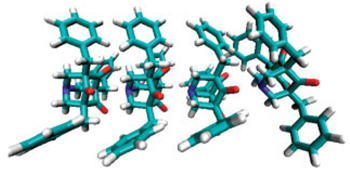
Electronic structure calculations are used to explore the nature of the interactions that lead to the self-assembly of a new class of functionalized donor-σ-acceptor molecules, 1-aza-adamantanetriones (AATs), and the consequences of molecular structure on the resulting supramolecular systems. The results show how the self-assembly process originates from the saturated core of the molecules that underlies their shape, conformational preferences, and dipole-directed one-dimensional assembly. The solvation properties of the monomers are explored and 1H NMR chemical shift values are determined and compared to experimental trends. A theoretical understanding of this class of supramolecular structures coupled with their molecular-level tunability introduces the possibility to design novel functional materials for specific electronic and optoelectronic applications.
